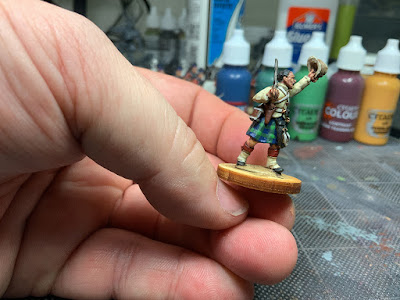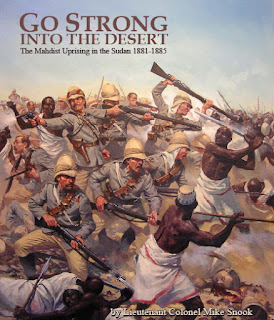 |
| Captain George H. Rippington III |
All of the paints are from Games Workshop's Citadel range. A brief note on my shorthand. 'Base Coat' is exactly what it sounds like... a solid layer of color painted as neatly as I can. When this is the same as the 'Primer' color (Zhadri Dust in this case), the area was simply left as is which greatly speeds up the painting process. 'Shade' always utilizes the Citadel range of washes or 'shades' which is painted completely over the base coat. 'Layer' is a color painted on that almost completely covers the color below, leaving the darker tones in recesses. This paint is thinned with a tiny amount of water to add a bit of transparency for a softer transition. If there are two 'Layers' in a sequence, the second is painted only on the upper surfaces (the top of arms, the edge of sleeves, collars, and tunics, etc), again thinned with a tiny amount of water. 'Highlight' refers to edge highlighting where only sharp edges or pinpoint highlights are applied. Don't worry about some variation in tones between models - uniforms would be far less... err... uniform after a few months in the Sudan!
Primer
Zhandri Dust Spray Paint
Helmet, Jacket, and Gaiters
Base Coat: Zhandri Dust
Shade: Agrax Earthshade
Layer: Tallern Sand
Layer: Ushabti Bone
Highlight: Screaming Skull (Helmet Only)
Puggaree
Base Coat: Zhandri Dust
Shade: Agrax Earthshade
Layer: Ushabti Bone
Shade: Reikland Fleshade
Valise Kit, Tassels, and Rifle Sling
Base Coat: Administratum Grey
Shade: Agrax Earthshade
Layer: Pallid Wych Flesh
Sporran, Mess Tin Cover, Scabbard, and Boots
Base Coat: Corvus Black
Shade: Agrax Earthshade
Highlight: Dawnstone
Stockings and Sergeants' Stripes
Base Coat: Mephiston Red
Shade: Agrax Earthshade
Layer: Evil Sunz Scarlet
Stripes: Corvus Black
Musket Stock
Base Coat: Rhinox Hide
Shade: Agrax Earthshade
Highlight: Doombull Brown
Canteen Cover and Pistol Holster
Base Coat: Mournfang Brown
Shade: Agrax Earthshade
Layer: Mournfang Brown
Highlight: Deathclaw Brown
Canteen, Bayonet, Sword Blade, and Rifle Barrel
Base Coat: Iron Warrior
Shade: Agrax Earthshade
Highlight: Stormhost Silver (Bayonet Only)
Buttons, Buckles, Sword Hilt, and Rifle Butt Plate
Bace Coat: Liberator Gold
Shade Agrax Eartshade
Highlight: Liberator Gold
Ok... let's pause here for a moment. If you've read this far (what about the bloody tartan? I'm getting to it...) you've probably seen that ALL of these areas are shaded with Agrax Earthshade. To save yourself a huge amount of time, paint all of the base coats on these areas and then shade the entire model before moving on to anything else. After you've finished all of your layers and highlights, you can go back with Agrax Earthshade if necessary and fix any areas where belts may have strayed into one another, to bring out buttons, etc. This will give you a nice, dark edge around the flesh areas too...
Skin
Base Coat: Bugman's Glow
Shade: Reikland Fleshade
Layer: Cadian Fleshtone
Highlight: Kislev Flesh
Kilt
Ok, here we go.. first of all there is no shading or highlighting required. The pattern is busy and the fact that we've left off this stage won't be noticed and would be an even bigger mess than it already is. Having said this, painting the tartan isn't as difficult as it seems.
First, the diagram...
Don't worry about trying to work out how this falls into folds and such. I start by painting the bottom green stripe above the bottom edge and a parallel one midway between the first and the figure's belt. then paint the vertical stripes as evenly as possible all the way around.
No... Citadel hasn't started making paint in dropper bottles. I made these myself. I'll write a post on it at some point if anyone is interested in the how and why.
Base Coat: Kantor Blue
First Stripes: Waagh Flesh
Intersect Squares: Warboss Green (you can stop here for the Black Watch tartan!)
Red Stripes: Flesh Tearers Red
Yellow Stripes: Averland Sunset
The 'Intersect Squares' will likely end up more as dots than squares, but that's ok. The last two colors should be painted with the finest-tip brush you have. Flesh Tearers Red is a Citadel Contrast paint, which means it is somewhat translucent. This is perfect to mimic the stitching of the real thing. It's also thinner than 'normal' paint, which makes it perfect for painting fine lines. There should be TWO parallel red stripes for each one above, but at 28mm, they are lucky to get one. The yellow stripes seem to fall between every other red, so in the case of my models, there is only one about midway up. There would be vertical yellow stripes in the same manner, but I've chose to pretend they are all hidden in the creases! Since there isn't any shading, you can touch up errant strokes with Kantor Blue or Waagh Flesh as necessary, but you only need to correct egregious mistakes.
Stage by stage photos to better illustrate... looks a bit naff viewed at such size and I shudder to publish such pictures, but no sacrifice on my part is too great for you! The illusion works at normal scale - especially when they are seen from three feet away on the game table.
NOTE: The above figure was painted before I settled on my final khaki recipe so appears a little lighter than the finished versions (see the good captain at the start of the post). I wanted the jacket to be a shade darker to better contrast with the white belts and straps.
Finally, here are recipes for alternate colors you might see on British troops in the Sudan:
Alternate Red Coat
Base Coat: Mephiston Red
Shade: Agrax Earthshade
Layer: Mephiston Red
Highlight: Evil Sunz Scarlet
Alternate Grey Coat
Base Coat: Mechanicus Standard Grey
Shade: Agrax Earthshade
Layer: Mechanicus Standard Grey
Highlight: Dawnstone
Alternate Valise Kit (Bread Bag should still be 'white')
Base Coat: Zhandri Dust
Sade: Agrax Earthshade
Layer: Talleran Sand
Highlight: Ushabti Bone
I would only use the alternate valise kit color with the red or grey coat. Rifle units may still have black valise kits at this time and I would use the same formula as for the mess kit and boots above.
Right! Clear as mud? Hopefully this is useful to someone - at least it will help me later! If you have questions, please don't hesitate to ask.
More soon...























